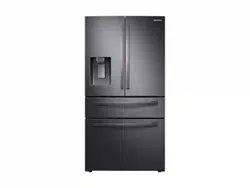Documents: Go to download!
User Manual
- User Manual - (English, French, Spanish)
- Energy Guide - (English)
- Specification - (English)
- Spec Sheet (web) - (English)
- Installation
- Operations
- Maintenance
- Troubleshooting
Table of contents
Refrigerator User manual
Free Standing Appliance
2019-05-17 Document PDRAW2- FSDAGS- 03873A-00EN.indd 1
Installation
Follow these instructions carefully to ensure a proper installation of this refrigerator and to prevent accidents before using it. /A\ WARNING
+ Use the refrigerator only for its intended purpose as described in this manual.
+ Any servicing must be performed by a qualified technician.
+ Dispose of the product packaging material in compliance with the local regulations.
+ To prevent electric shock. unplug the power plug before servicing or replacing parts.
Refrigerator at a glance
The actual refrigerator and provided component parts of your refrigerator may differ from the illustrations in this manual. depending on the model and the country.
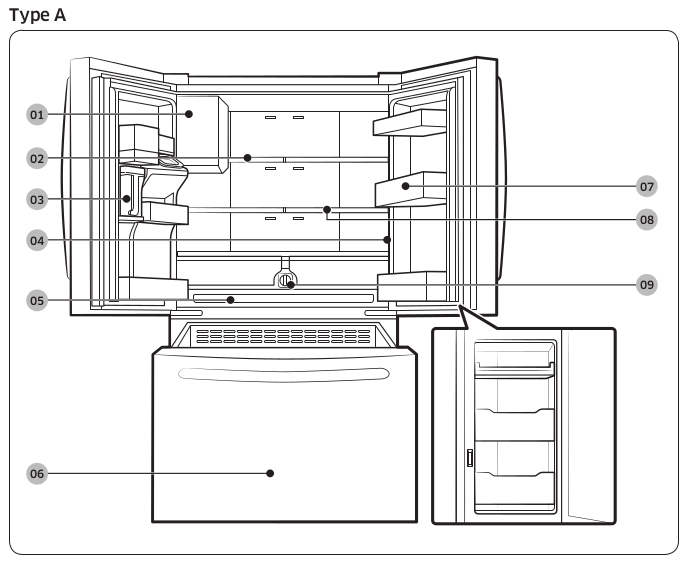
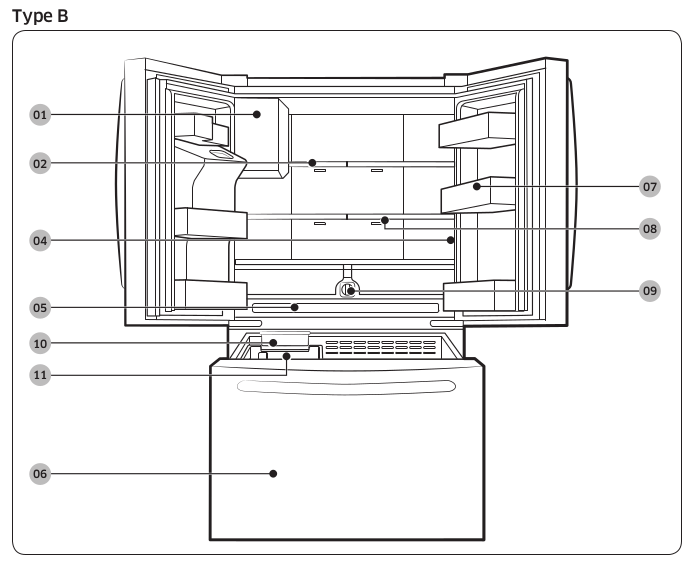
01 Auto Ice Maker
02 1-Step Foldable Shelf
03 Autofill Pitcher *
See other models: HW-R450/ZA SM-G970UZBAXAA VR1AM7040WG/AA SM-G975UCWEATT RF28HDEDBSG/AA
04 Main panel
05 Cool Select Zone
06 Freezer
07 Door bins
08 2-Step Foldable Shelf
09 Water filter
10 Ice Maker *
11 Ice bucket *
* applicable models only
Note
- For energy efficiency. keep all shelves. drawers. and baskets in their original positions.
- When closing the door. make sure the vertical hinged section is in the correct position to avoid scratching the other door.
- If the vertical hinged section is reversed. put it back into the correct position. and then close the door
- Moisture may form at times on the vertical hinged section
- If you close a door forcefully. the other door may open.
- When a door is opened. the interlock switch automatically disables the auger motor of the ice maker for safety reasons.
- If the internal or external LED lamp is out of order. contact a local Samsung service center.
- If the door is left open for too long. the top internal LED will blink. This is normal
Step-by-step installation
STEP 1 Selecta site
Select a site that:
+ Hasa solid. level surface without carpeting or flooring that may obstruct ventilation
+ Is away from direct sunlight
+ Has adequate room for opening and closing the door
+ Is away from any heat sources
+ Provides room for maintenance and servicing
+ Has a temperature range between 50 °F (10 °C) and 109 °F (43°Q
CAUTION
+ If your refrigerator is equipped with an ice maker. provide extra space at the rear of the refrigerator for the water line connection
+ When you install the refrigerator next to a fixed wall. you must provide a minimum clearance of 3 2/4" (95 mm) from the wall to allow the door to swing open
Note
To facilitate moving your refrigerator to its final location. be sure to measure the width and height of doorways. thresholds. ceilings. stairways. and anything else that needs to be taken into consideration to ensure you can move your refrigerator safely. The following diagram illustrates the exact height and depth (factory specifications) of your refrigerator.
Clearance
See the following figures and tables for space requirements for installation
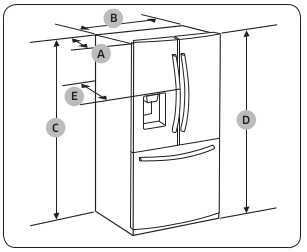
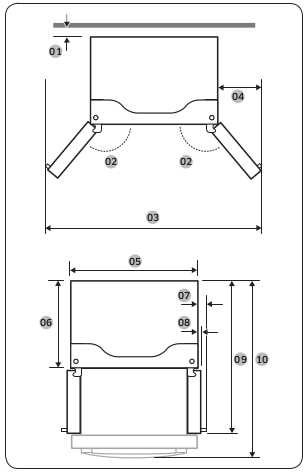
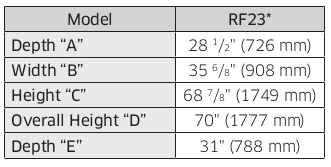
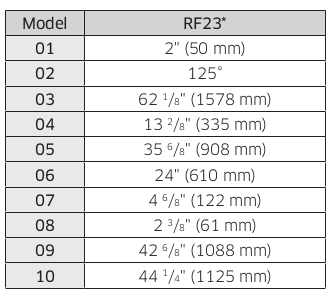
Note
The measurements in the table above may differ slightly from the actual measurements. depending on the measuring and rounding method
STEP 2 Flooring
If the refrigerator cannot pass through the entrance due to its size. see STEP 3 Door removal for entrance.
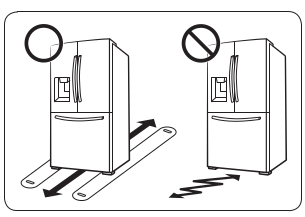
Note
To prevent floor damage. make sure the front leveling legs are in the upright position
+ The surface you install the refrigerator on must support a fully loaded refrigerator.
+ To protect the floor. put a large piece of cardboard along the path to the refrigerator's final installation location.
+ Once the refrigerator is in its final position. do not move it unless necessary to protect the floor. If you have to move the refrigerator. place thick paper or cloth such as old carpets along the path of movement
STEP 3 Door removal for entrance
If the refrigerator cannot pass through the entrance to your home or kitchen due to its size. follow these instructions to remove and then re-install the refrigerator's doors. If you do not need to remove the doors. go to page 29 to continue the installation procedure.
WARNING
Unplug the power cord of the refrigerator before removing the doors.
Detach the fridge doors
Left door
1. With the doors closed. use a Phillips head screwdriver to remove the screws (x3) in the top cover.
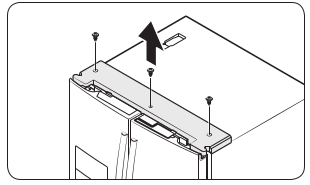
2. Disconnect the wires and the water tube from the left-side door. Do the following sequentially:
+ Decouple the connector
+ While holding down one end of the water line coupler. disconnect the water tube

CAUTION
Keep the water tube clips out of children’s reach.
3. Gently draw up the clamp. To prevent finger injuries. do not apply a sudden force to the clamp.

4. Pull the clamp to remove it.
NOTE
Be careful not to drop the clamp on the floor.
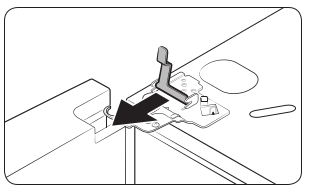
5. Open the door 90 degrees. While holding the door. pull up and remove the top hinge. Be careful not to damage the connector wires when you remove the hinge
Note
Be careful not to drop the hinge on the floor.
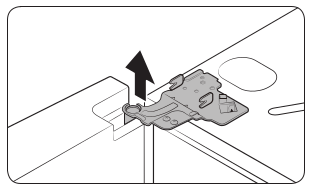
Gently pull up the door vertically to remove. Do not apply excessive force to the door. The door may fall. causing physical injury.
7. Lay the door down on a flat surface.
CAUTION
Please put the door down slowly to prevent scratches.

Right door
1. Disconnect the wire connectors (x2) on the right door. The position of the connectors differs with the model.
CAUTION
Do not remove both doors simultaneously. Make sure to remove one door at a time. Otherwise. one of the doors may fall and cause physical injury.
Make sure the refrigerator is off before disconnecting the connectors.

2. Gently draw up the clamp. To prevent finger injuries. do not apply a sudden force to the clamp.

3. Pull the clamp to remove it.
Note: Be careful not to drop the clamp on the floor.
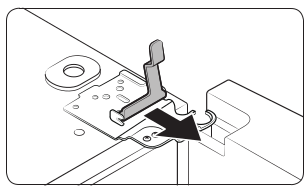
4. Open the door 90 degrees. While holding the door. pull up and remove the top hinge. Be careful not to damage the connector wires when you remove the hinge
Note: Be careful not to drop the hinge on the floor.

5. Gently pull up the door vertically to remove. Do not apply excessive force to the door. The door may fall. causing physical injury.
6. Lay the door down on a flat surface.

To reattach the fridge door
After you have moved the refrigerator to its final location. reattach the doors by following the removal instructions in reverse order.
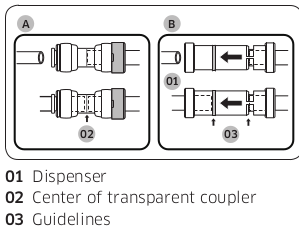
To detach the freezer drawer
CAUTION
To prevent water leaks from the dispenser. the water line must be fully connected Make sure both tubes of the water line are inserted fully to the center of transparent coupler (A) or the guidelines (B)
1. Lift up the front of the upper basket and pull to remove.
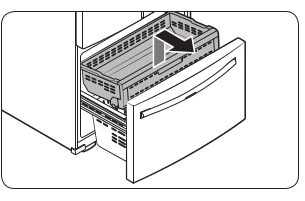
2. Lift the door bin to remove.
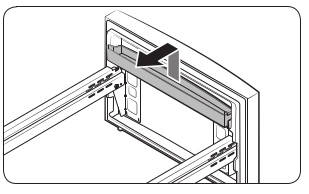
3. Then. pull up to remove the lower basket from the rail assembly.
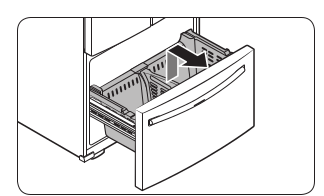
4. Press down the hooks to unlock the rail assembly.

5. While holding the upper area of the freezer drawer front. slide the drawer out all the way to remove the freezer drawer from the rail assembly.
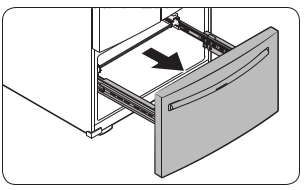
CAUTION
Be careful not to scratch or dent the rail assembly.
Make sure you mount the freezer baskets in the correct position Otherwise. the door will not open or close properly. which causes frost to build up.
Do not store too much food in the freezer drawer. This prevents the freezer drawer from closing properly. resulting in frost buildup.
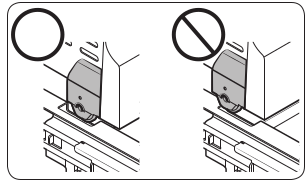
To reattach the freezer drawer
Once the refrigerator is in or near its final location. re-attach the freezer drawer by following the directions in the reverse order of removal.
STEP 4 Leveling the refrigerator
CAUTION
+ When installed. the refrigerator must be leveled on a flat. solid floor. Not leveling the refrigerator can cause damage to the refrigerator or physical injury.
+ Leveling must be performed with the refrigerator empty. Make sure no food items are inside the refrigerator.
+ For safety reasons. adjust the front a little higher than the rear.
Level the refrigerator using the special screws (levelers) on the front legs. Use a flat-head screwdriver to turn the levelers.

To adjust the height of the left side:
- Insert a flat-head screwdriver into the leveler of the left side front leg. Turn the leveler clockwise to raise the left side or turn it counterclockwise to lower.
To adjust the height of the right side:
- Insert a flat-head screwdriver into the leveler of the right side front leg. Turn the leveler clockwise to raise the right side or turn it counterclockwise to lower
STEP 5 Adjust the door height and the door gap
Snap rings
The height of a door can be adjusted using the provided snap rings. which come in 4 different sizes (1 mm. 1.5 mm. 2mm. and 2.5 mm)

To adjust the height of a door
1. Check the height difference between the doors. and then lift up and hold the door with the lower height.
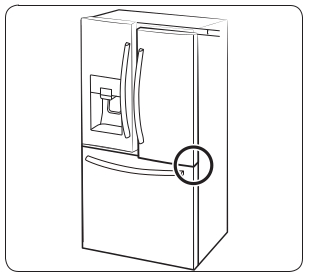
2. Insert a suitable-sized snap ring (A) between the door grommet (B) and the hinge as shown.
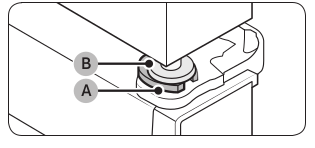
CAUTION
+ Insert only one snap ring. If you insert two or more snap rings. the rings may slip out or make a rubbing noise
+ Keep the snap rings out of children's reach and keep them for future use
+ Do not raise the door too much. The door can contact and damage the top cover.
STEP 6 Attach the handles
CAUTION
The refrigerator handles must be oriented in the correct direction
+ The fridge handles must be attached so that the holes on each face each other.
+ The freezer handle must be attached so that its hole faces downwards.
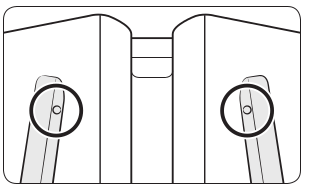
1. Using a Phillips screwdriver. attach the handle screws to the refrigerator. two for each handle respectively. as shown in the illustration to the left.

2. Attach the handle to the handle screws on the door.

For type B handle: Insert the hook on the middle of the handle to its designated hole on the door. and then place the upper and lower part of the handles to the handle screws.
NOTE: The design of the right side door handle may differ depending on your model
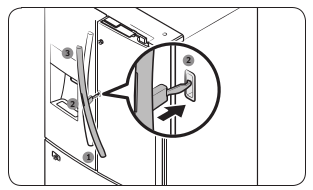
3. Push the handle down.

4. Insert the supplied wrench into the handle hole. and then turn it clockwise to tighten.
5. Repeat Steps 2 through 4 with the second refrigerator door handle
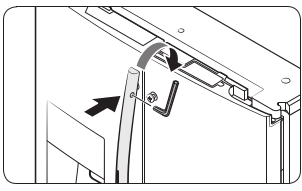
6. To attach the freezer handle to the refrigerator. first place the left side of the freezer handle onto the left handle screw. and then push it to the left.
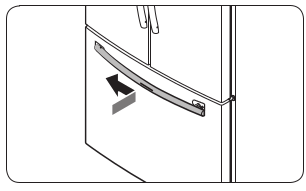
7. Then. place the right side of the freezer handle onto the right handle screw.

8 Insert the supplied wrench into the handle hole. and then turn it clockwise to tighten.
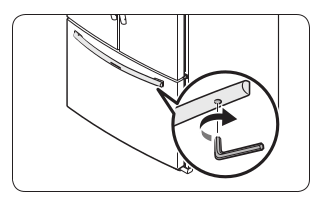
STEP 7 Connect the water dispenser line
A water dispenser with a filter is one of the helpful features on your new refrigerator. To help promote better health. the water filter removes unwanted particles from your water.
However. it does not sterilize or destroy microorganisms. You may need to purchase a water purifying system to do that.
The water line also connects to the ice maker. For the ice maker to operate properly. water pressure of 30 to 120 psi (206 to 827 kPa) psi is required
If the refrigerator is installed in an area with low water pressure (below 30 psi / 206 kPa). you can install a booster pump to compensate for the low pressure
After you have connected the water line. make sure the water storage tank inside the refrigerator is properly filled. To do this. press the water dispenser lever until water runs from the water outlet.
Note
+ Water line installation kits are available at extra cost from your retailer. We recommend using a water line installation kit that contains copper tubing and a */." (6 mm) compression nut.
1. Shut off the main water source
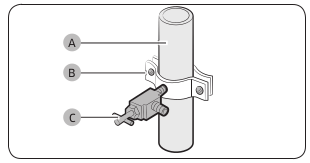
2. Insert the pipe clamp (B) and the shutoff valve (Q) into the cold water line (A).
3. Connect the water line installation kit (A) to the shutoff valve (B).
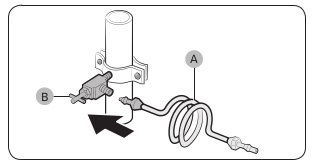
Connect the water supply line to the refrigerator
There are several items you must purchase to complete this connection. You may find these items sold as a kit at your local hardware store.

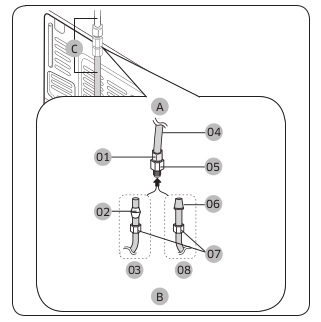
A. Refrigerator
B. Household water supply line
C. Water Line: must be kept straight.
01 Compression Nut (*/s’) (Assembled)
02 Ferrule (Not supplied)
03 Copper tubing (Not supplied)
04 Plastic Tubing (Assembled)
05 Compression Fitting (Assembled)
06 Molded end (Bulb)
07 Compression nut (B) (?/«") (Not supplied)
08 Plastic Tubing (A) (Not supplied)
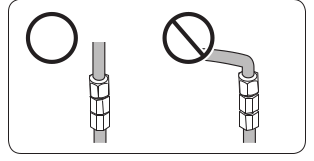
NOTE: If you have to relocate the refrigerator after connecting the water line (C). make sure the joined section of the water line is straight.
CAUTION
Do not mount the water filter on any part of the refrigerator. This may damage the refrigerator.
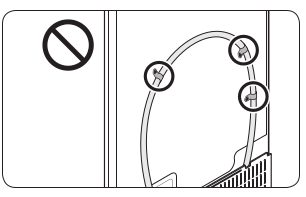
1. Connect the household water line to the assembled compression fitting
If you are using copper tubing. slip the compression nut (B) (not supplied) and ferrule (not supplied) on the copper tubing (not supplied) as shown ~ If you are using plastic tubing (A). insert the molded end (Bulb) of the plastic tubing (A) into the compression fitting
CAUTION
+ If you use plastic tubing (A). do not use it without the molded end (Bulb)
+ Leaving the water line disconnected may cause the water valve to produce a buzzing sound over time. If this is the case. make sure that the ice making function is turned “OFF” and do not attempt to use the water dispenser
2. Tighten the compression nut (B) onto the compression fitting. Do not over-tighten the compression nut (B).
3. Turn the water on and check for any leakage. If you find water drops or leakage in the connection areas. turn off the main water supply. Check the connections and. if necessary. tighten
4. Flush 1 gallon of water through the filter before drinking or using the water from the refrigerator. (Flush approximately 6 minutes) To flush. press a large glass or cup against the water dispenser lever. Fill the glass. empty it. and then repeat.
5. After you turn on the refrigerator. let the ice maker make ice for 1 to 2 days. Over that period of time. throw out the first 1 or 2 buckets of ice the ice maker makes to ensure all impurities have been removed from the water line
Note
Only connect the water line to a potable water source.
+ If you have to repair or disassemble the water line. cut off */:" of the plastic tubing to make sure you get a snug. leak-free connection.
+ You can test the water line quickly using a paper cup. Under normal conditions. the water dispenser can fill a 5 °/« oz. (170 cc) cup in about 10 seconds.
STEP 8 Initial settings
By completing the following steps. the refrigerator should be fully functioning
1. Plug the power cord into the wall socket to turn the refrigerator on
2. Open the door. and check if the interior light lights up.
3. Set the temperature to the coldest setting. and wait for about an hour. Then. the freezer will be slightly chilled. and the motor should be running smoothly.
Wait until the refrigerator reaches the set temperature. Now the refrigerator is ready for use
STEP 9 Final check
When installation is complete. confirm that
+ The refrigerator is plugged into an electrical outlet and grounded properly.
+ The refrigerator is installed on a flat. level surface with a reasonable clearance from walls and cabinets.
+ The refrigerator is level and is sitting firmly on the floor.
+ The door opens and closes freely. and the interior light turns on automatically when you open the door.
Operations
Main panel
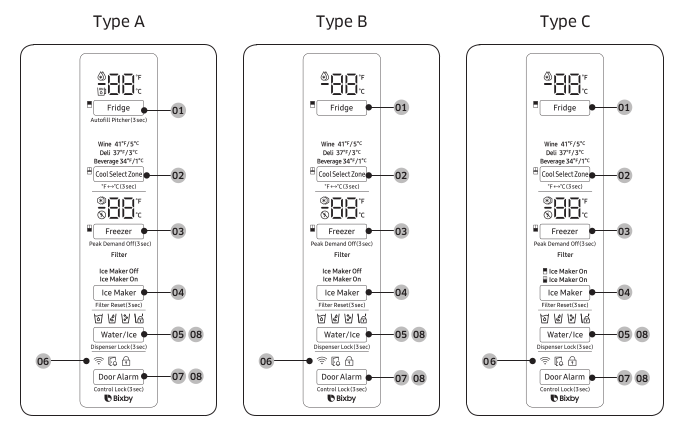
01 Fridge / Autofill Pitcher *
02 Cool Select Zone / °F + °C
03 Freezer / Peak Demand Off
04 Ice Maker / Filter Reset *
05 Water/Ice / Dispenser Lock
06 Network connection
07 Door Alarm / Control Lock
08 Sabbath Mode
* applicable models only
Please download the pdf file to read about the operation.
Maintenance
Handling and care
Ice bucket (applicable models only)
If you do not dispense ice for an extended period. ice may form clumps inside the bucket.
If this happens. remove and empty the ice bucket.
1 To remove the ice bucket. gently lift it up. and then pull it out slowly while holding the bottom of the bucket with one hand and the side with the other hand.
2. Empty the bucket
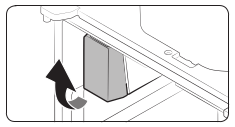
3. When done. put the bucket back into
Position. If the bucket does not fit in. turn the helix screw 90 degrees. and then try again.
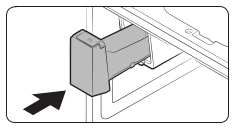
If the ice bucket is not firmly inserted turn the Helix (A) 90 degrees. and then try again.
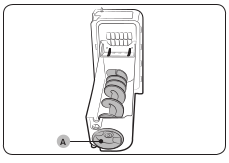
CAUTION
+ Do not apply excessive force to the bucket cover. The cover may break
+ Do not forcefully close the door. Water may spill over the ice maker.
+ Toprevent injury. make sure to clean up any ice or water that has fallen on the floor.
+ Toprevent accidents ar injury. do not let children play with the water dispenser or the ice maker.
+ Do not put your hand or an object into the ice chute. This may cause physical injury or product damage.
+ Use only the provided ice bucket. Third-party ice buckets may cause a system failure.
Note
+ The water pressure required for ice making is between 30 to 120 psi (206 to 827 kPa).
+ Noise from the ice maker as it produces ice during the ice making process is normal.
+ While the door is open. neither the ice maker nor the water dispenser operates.
Autofill pitcher (applicable models only)
1. Grasp a handle groove of the sealed mouth. and then pull up to remove.
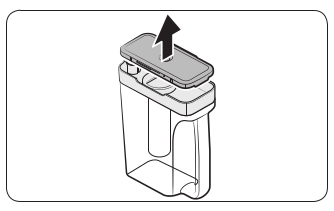
2. Grasp both sides of the sealed mouth. and then lift to remove.
3. While slightly twisting the infuser. pull it out of the sealed mouth
4. Clean the infuser with neutral agents and running water. Rinse and dry well.
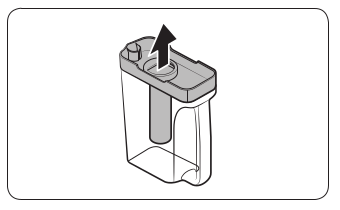
5. Reassemble the Autofill pitcher in the reverse order of disassembly.
CAUTION
Water pitcher and lid are not dishwasher safe and can deform under high temperatures. Please hand wash as needed.

Fridge shelves
The appearance of the shelves differs by model
+ Toremove a shelf. fully open the corresponding door. Hold the front of the shelf. and then gently lift up and slide out.
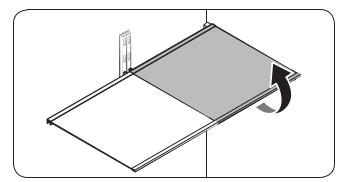
Note
Do not lift up the shelf fully when removing or reinserting the shelf. The rear wall of the fridge room can be dented.
To reinsert. hold the shelf at an angle so the front is higher than the back. and then insert the top hook into the top shelf notch. Then. lower the shelf and insert the bottom shelf hook into the bottom shelf notch.
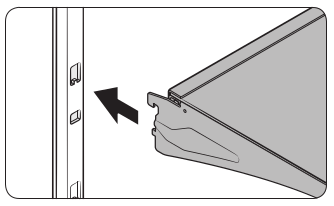
CAUTION
The tempered glass shelves are heavy. Use caution when removing them.
The shelf must be inserted correctly. Do not insert upside down.
Glass containers may scratch the surface of glass shelves.
You must insert the right-side shelf first. and then insert the left-side shelf.
If you do not follow this order. locking mechanisms on the shelve cannot properly locked.
Foldable shelf
To remove. slide up the front of the shelf so that it folds. Then gently lift up and pull out. To reinsert. place the shelf on the angled frame in the main unit. and then. press down to unfold
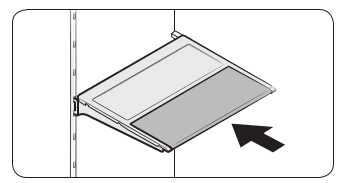
CAUTION
After sliding the foldable shelf in and folding it. the front of the shelf can be removed for your convenience. If you use the shelf without removing the front of the shelf. be aware that it can separate from the rear portion. Take care when handling food items near the shelf.
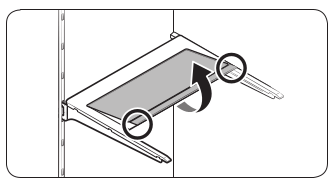
Recommended foldable shelf location
The foldable shelf folds up from the center. giving you more room for storage.
+ Insert the shelf in the right side of the fridge. Left side insertion does not allow the shelf to fold completely.
+ To fold. push the front area of the shelf inward so that it folds up from the middle.
CAUTION
Do not lift up quickly or twist the foldable shelf to take out food under it. It may fall off.
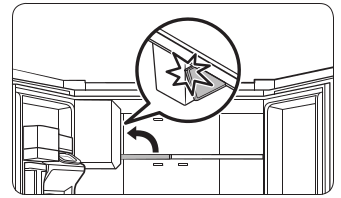
Vegetable shelf
1. Slide out the left-side vegetable drawer.
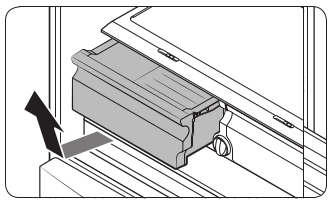
2. While supporting the vegetable shelf with one hand. slide it out with the other hand.
Note
To use the space that is opened up after removing the glass shelf. take out the vegetable shelf.
To reinsert. follow the steps above in the reverse order.
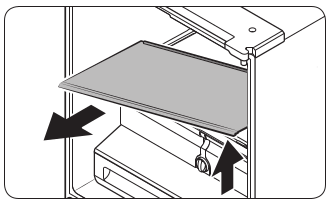
Door bins
To remove the door bin. hold the front sides of the bin. and then gently lift up to remove.
To reinsert. insert the door bin slightly above its final location making sure that the back of the bin is against the door.
Hold the rear of the door bin with both hands. and then press down so that it fits snugly.
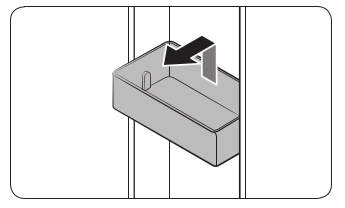
CAUTION
Do not remove a bin that is filled with food. Empty the bin beforehand.
Use caution when opening the door if the bottom bin contains larger bottles. which may fall over.
Do not allow children to play with the bins. Sharp corners of the bin may cause injury.
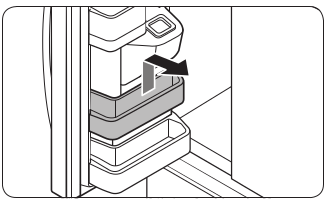
Fridge drawers
Vegetable / fruit drawers
Gently lift up the front of the drawer and slide out.
We recommend that you remove the door bins before removing the drawer.
This is to prevent damage to the door bins.
To reinsert. insert the drawer into the frame rails and then slide inward.
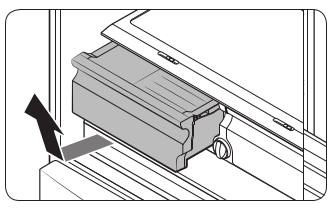
Cool Select Zone
To remove. fully open the Cool Select
Zone. Then. slightly lift the front side and pull straight out.
To reinsert. push the rails to the back of the refrigerator. Then. place the Cool
Select Zone drawer onto the rails and slide it back until it is in place.
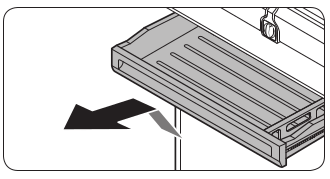
To remove the divider. lift the front side of the divider to unhook it from the wall. and then pull the divider out.
To reinsert the divider. hook the back of the divider over the rear wall. and then push the divider down.
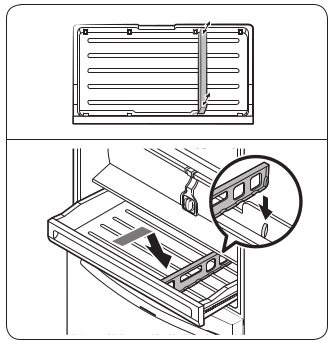
Freezer baskets
Lower ice bucket (applicable models only)
1. Fully open the freezer drawer.

2. Lift the lower ice bucket to remove.
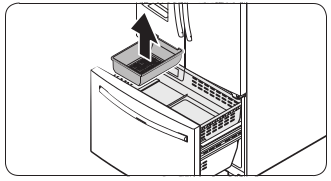
Upper basket
To remove. fully slide open the freezer drawer. Lift up the front of the upper basket and pull to remove.
To reinsert. align the front wheels of the upper basket with the end of the lower basket. Slide the upper basket to the front.
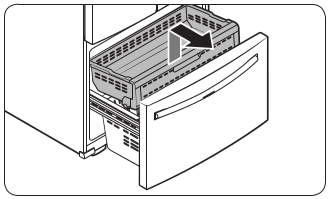
Lower basket
+ Toremove. first remove the upper basket. Then. tilt up the front of the lower basket to pull out.
+ Toreinsert. put the basket onto the rail assembly rear side first.

CAUTION
Do not twist the basket when removing or reinserting the basket. The basket can be scratched.
To prevent physical injury. property damage. or suffocation. keep children away from freezer baskets that have been removed.
Do not remove the divider.
Put the wheels of the upper basket on the end of the rails of the lower basket. Then. slide the upper basket all the way to the front. Otherwise. the drawer will not open or close properly. which will cause frost to build up.
Freezer basket divider
Loosen and remove the screw from the lower side of the divider. Then. pull straight up to remove the divider.
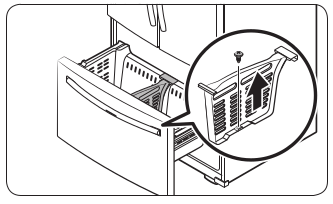
Interior and exterior
WARNING
+ Do not use benzene. thinner. home/car detergent. or Clorox to clean the refrigerator.
They may damage the surface of the refrigerator and cause a fire.
+ Do not spray water onto the refrigerator. This may cause electric shock.
Regularly use a dry cloth to remove all foreign substances such as dust or water from the power plug terminals and contact points.
1. Unplug the power cord.
2. Use a moistened. soft. lint-free cloth or paper towel to clean the refrigerator’s interior and exterior.
3. When done. use a dry cloth or paper towel to dry well
4. Plug in the power cord.
Ice / Water dispenser
CAUTION
When crushed ice is selected. some residual ice chips may collect in the ice chute. To prevent this. remove the residual ice from the chute using a soft. clean cloth.
Rubber seals
If the rubber seals of a door become dirty. the door may not close properly and reducing refrigerator performance and efficiency. Use a mild detergent and damp cloth to clean the rubber seals. Then. dry well with a cloth.
Rear panel
To keep cords and exposed parts of the rear panel free of dirt. vacuum the panel once or twice a year.

CAUTION
Do not remove the rear panel cover. Electric shock may occur.
Replacement
Water filter
WARNING
+ Do not use third-party water filters. Use only Samsung-provided or -approved filters.
+ Unapproved filters may leak and damage the refrigerator. causing electric shock. Samsung is not responsible for any damage that may occur from use of third-party water filters.
The Filter Reset indicator (Filter ) turns red to let you know it is time to replace the water filter. Before replacing the filter. make sure the water supply line is shut off.
1. Shut off the water supply line.
2. Turn the knob of the filter cartridge 90 degrees counterclockwise (1/4 turn).
The filter cartridge unlocks.

3. Pull out to remove the cartridge.
If the water filter is severely contaminated. the cartridge may not be easy to remove. If that is the case. use force to remove the cartridge.
To prevent water leaks from the filter opening. pull the cartridge straight out while removing it.
4. Insert a new filter cartridge. Use only
Samsung-provided or approved filters.
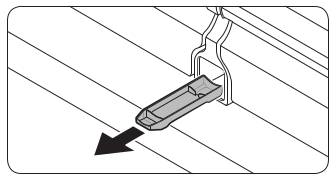
5. Turn the cartridge knob clockwise to lock into place.
6. Press and hold Ice Maker on the main panel for 3 seconds to reset the life cycle detector. The Filter Reset indicator (Filter ) turns off.
7. When you are done replacing the filter. open the water valve and run water through the dispenser for about 7 minutes. This is to remove impurities and air from the water line.
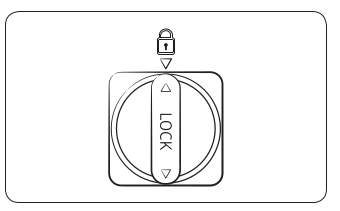
Note
+ Anewly installed filter may cause the water dispenser to spurt water briefly. This is because air has entered the waterline.
+ The replacement process may cause the water dispenser to drip for a short period of time. If it drips. simply wipe up any water on the floor with a dry towel
Reverse osmosis water filtration system
The water pressure of the water supply system to a reverse osmosis water filtration system must be between 30 to 120 psi (206 to 827 kPa).
The water pressure of the reverse osmosis water filtration system to the refrigerator's cold water line must be at least 40 psi (276 kPa). If the water pressure is below these specifications:
+ Check if the sediment filter in the reverse osmosis system is blocked. Replace the filter if necessary.
+ Refill the water tank in the reverse osmosis system with water.
+ If your refrigerator has a water filter. it may further reduce the water pressure when used in conjunction with a reverse osmosis system. Remove the water filter.
For more information or servicing. contact a licensed plumbing professional
Ordering a new filter
To purchase a new water filter. contact a local Samsung service center or visit www. samsungparts.com on the web.
LED Lamps
To replace the lamps of the refrigerator. contact a local Samsung service center.
WARNING
+ The lamps are not user-serviceable. Do not attempt to replace a lamp yourself. This can cause electric shock.
Troubleshooting
Before calling for service. review the symptoms and recommended solutions below. If none of the suggested solutions resolve your problem. please visit our website at www. samsung.com or call Samsung Customer Care at 1-800-SAMSUNG (726-7864). Note that you will be charged for any service visits in which no defects were found.
Fridge/freezer does not operate. Fridge/freezer temperature is warm.
Power cord is not plugged in properly.
+ Properly plug in the power cord.
Temperature control is not set correctly.
+ Set the temperature lower.
Refrigerator is located near a heat source or direct sunlight.
+ Keep the refrigerator away from direct sunlight or a heat source.
Not enough clearance between refrigerator and nearby walls or cabinets.
+ Make sure there is a gap of at least 2.5 inches (5 cm) between the refrigerator back and sides and any nearby walls or cabinets.
Energy Saver mode is activated.
+ Deactivate Energy Saver mode.
The refrigerator is overloaded. Food is blocking the refrigerator vents.
+ Do not overload the refrigerator. Do not allow food to block vents.
Fridge/freezer is over-cooling.
Temperature control is not set correctly.
+ Set the temperature higher.
Interior wall is hot.
Refrigerator has heat-proof piping in the interior wall.
+ To prevent condensation from forming. the refrigerator has heat-proof piping in the front corners. If the ambient temperature rises. this equipment may not work effectively. This is not a system failure.
Refrigerator has odors.
Spoiled food.
+ Clean the refrigerator and remove any spoiled food.
Food with strong odors.
+ Make sure strong smelling food is wrapped airtight.
Frost around the vents.
Food is blocking the vents.
+ Make sure no food blocks the refrigerator vents.
Frost on interior walls.
Door is not closed properly.
+ Make sure food does not block the door. Clean the door gasket.
Fruits or vegetables are frozen.
Fruits or vegetables are stored in the Cool Select Zone.
+ Do not store most kinds of fruit or vegetables in the Cool Select Zone.
Condensation forms on the interior walls.
If door is left open. moisture enters the refrigerator.
+ Remove the moisture and do not leave a door open for extended periods of time.
Food with high moisture content.
+ Make sure food is wrapped airtight.
Water flow is weaker than normal.
Water pressure is too low.
+ Make sure the water pressure is between 30 to 120 psi (206 to 827 kPa).
Ice maker makes a buzzing sound.
The ice maker function is activated. but the water supply to the refrigerator has not been connected.
+ Press Ice Maker.
Ice maker does not make ice.
Ice maker has just been installed.
+ You must wait for 12 hours for the refrigerator to make ice.
Freezer temperature is too high.
+ Set the freezer temperature below 0 °F (-18 °C) or -4 °F (-20 °C) in warm ambient air.
Dispenser panel Lock is activated.
+ Deactivate dispenser panel Lock.
Ice maker is off.
+ Turn on the ice maker.
Ice does not dispense.
Ice may jam if the ice dispenser is not used for a long time (approx. 3 weeks).
+ If you won't be using the refrigerator for a long time. empty the ice bucket and turn off the ice maker.
Ice bucket is not properly inserted.
+ Make sure the ice bucket is properly inserted.
Water line is not connected properly or water supply is not on
+ Check if the water line is installed correctly. Check if the water line stop cock is closed.
Water does not dispense.
Water line is not connected properly or water supply is not on
+ Check If the water line Is installed correctly. Check if the water line stop cock is closed.
Dispenser panel Lock is activated.
+ Deactivate dispenser panel Lock.
A third-party water filter was installed.
+ Use only Samsung-provided or approved filters.
+ Unapproved filters may leak and damage the refrigerator.
Water filter indicator turns on or blinks.
+ Replace the water filter. After replacing. reset the filter indicator sensor.
Do you hear abnormal sounds from the refrigerator?
Before calling for service. review the information below. If you still have questions about sounds your refrigerator is making. please call Samsung Customer Care at
1-800-SAMSUNG (726-7864). Note that you will be charged for any service visits related to normal operating sounds in which no defects were found.
These sounds are normal.
When starting or ending an operation. the refrigerator may make sounds similar to a car engine ignition. As the operation stabilizes. the sounds will decrease.

While the fan is operating. these sounds may occur. When the refrigerator reaches the set temperature. the fan sound will stop.

During a defrost cycle. water may drip on the defrost heater. causing sizzling sounds.

As the refrigerator cools or freezes. refrigerant gas moves through sealed pipes. causing bubbling sounds.

As the refrigerator temperature increases or decreases. plastic parts contract and expand. creating knocking noises. These noises occur during the defrosting cycle or when electronic parts are working.

For ice maker models: When the water valve opens to fill the ice maker. you may hear a buzzing sound.
Due to pressure equalizing when you open and close the refrigerator door. you may hear a whooshing sound.
SmartThings
Could not find “SmartThings” in the app market.
- The SmartThings app is designed for Android 6.0 (Marshmallow) or later. iOS 10.0 or later. iPhone 6 or later. and is optimized for Samsung smartphones (Galaxy S and Galaxy Note series).
The SmartThings app fails to operate.
- The SmartThings app is available for applicable models only.
- The old Samsung Smart Refrigerator app cannot connect with Samsung Smart Home models.
The SmartThings app is installed but is not connected to my refrigerator.
- You must log into your Samsung account to use the app.
- Make sure that your router is operating normally.
- If you have not connected your refrigerator to the SmartThings App after the app was installed. you must make the connection using the device registration function of the app.
Could not log into the app.
- You must log into your Samsung account to use the app.
- If you don’t have a Samsung account. follow the app’s onscreen instructions to create one.
An error message appears when | try to register my refrigerator.
- Easy Connection may fail due to the distance from your access point (AP) or electrical interference from the surrounding environment. Wait a moment and try again.
The SmartThings app is successfully connected to my refrigerator but does not run.
- Exit and restart the SmartThings app or disconnect and reconnect the router.
- Unplug the power cord of the refrigerator. and then plug it in again after 1 minute.
What Do i Need to use the Energy Management and Smart Grid functions?
To use the Smart Grid (Demand Response) and Energy Management functions on your refrigerator. you need the following:
Devices
+ Avwireless access point (router)
+ A Samsung Energy Management-supported refrigerator
+ Asmartphone
Registration
+ Connect your refrigerator to your home Wi-Fi network.
+ Register for the EMS service with your electric company.
Your electric company must have an EMS (Energy Management System) supporting SEP (Smart Energy profile).
App
+ Download the SmartThings app from the Google Play Store. Apple App Store. or Samsung Galaxy Apps.
+ Install and run the SmartThings app on your smartphone.
Why isn’t the Energy
Management function working normally?
+ Make sure that your home router is operating normally with proper Internet service and connection.
+ Make sure that the refrigerator is connected to the AP (router).
Checkpoints
+ Connect your smartphone to the router (AP. Access Point). and then check if you can browse the Internet on the smartphone.
Why isn’t the Delay
Defrost Capability working normally?
Make sure that your home router is operating normally with proper Internet service and connection.
